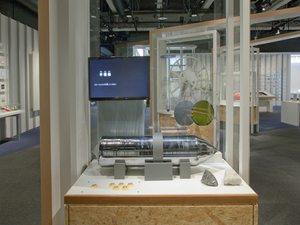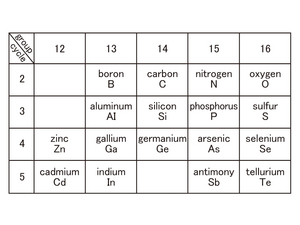Nagoya City Science Museum
TOP > Exhibition Guide > Keyword Search > Starting with "S" > semiconductor > Semiconductor
Semiconductor



Purpose of Exhibition
The electronic parts used in PC's, mobile phones and electric appliances are made with materials called "semiconductors".
Semiconductors have an interesting electric characteristic.
In this exhibit, we will explain its mechanism and materials as to what semiconductors are with visual and actual examples.
Additional Knowledge
[What are Semiconductors?]
Conductors are materials which discharge electricity, and materials that don't discharge electricity are called "insulators", like rubber.
The materials between such conductors and insulators are called "semiconductors". In addition, electrical components made out of semiconductors (semiconductor devices) are also referred to as "semiconductors".
Semiconductor materials include the following:
As for simple substances (substances made out of only one chemical element), silicon in group 14 of the periodic table of the chemical elements and germanium are semiconductors.
Also for compounds, a combination of group 13 aluminum, gallium and indium , and group 15(phosphorus and arsenic) like gallium arsenide are semiconductor compounds.
There are also semiconductors made out of group 12 (zinc, cadmium, indium) and group 16(oxygen, sulfur, etc.) composed of three and four chemical elements. A typical semiconductor, the chemical element silicon exists in large quantities on earth, mostly contained in rocks. Silicon is also heat resistant, and has the useful characteristic of easily creating silicon dioxide, the membrane of insulators. Therefore, silicon has played a main role in semiconductors. The silicon we often use for household use is another substance entirely.
Table 1Chemical elements whose names frequently occur as semiconductor materials
[Characteristics of Semiconductors]
As for semiconductors such as metals, the higher their temperature gets, the less easily electricity passes through. On the other hand, semiconductors are more likely to allow electricity to flow through.
The type of semiconductor and combinations of heat, light, voltage and external factors mainly cause the volume and direction of electricity to change, that is, they manipulate flow of electricity.
[Functions of 2 kinds of Semiconductors]
A typical semiconductor is silicon.
Only silicon has very few free electrons for practical use. By mixing more pure silicon with small amounts of impurities, you can create a P- type of semiconductor and N- type of semiconductor, which are artificial semiconductors.
Roughly speaking, P-type is electrically minus, with not enough electrons.
N-type has an excess of electrons.
The same is true for other semiconductor materials.
With P-type and N-type semiconductors produced, various functional
semiconductors are produced. A few cases are given here:
[Diode]
A diode is a mixture of P-type and N- type semiconductors. If electricity flows from the positive pole of the P-type semiconductor, if connected in reverse, it does not flow anymore. Therefore, the diode AC (electricity flow changes direction constantly) can be changed to DC (electricity flows only in one direction).
This is called the rectifying action.
[Light Emitting Diode LED]
When electrified, a diode emits light. It is used for traffic lights, illuminations and back-lights of LCD screens. The emitting color changes according to the impurities added and the semiconductor materials. For example, infrared is emitted from a semiconductor called gallium arsenide (GaAs) and a blue color light from a semiconductor called gallium nitride (GaN)There is one type of white color diode emitting red, blue and green light, and fluorescent type of blue color light-emitting diode.
[Photodiode]
Conversely to emitting diodes, this diode receives electric light. For example, it is this part that receives the infrared in a remote control.
[Transistor]
A transistor is arranged as P-type and N-type semiconductors in PNP or NPN order.
This function amplifies small electrical signals as they are. The above example is a single electronic component. These components, which are assembled, connected and play a role as an electronic component, are integrated circuits (IC).
They are used considerably around us as IC chips, CPUs, USB memory (flash memory), CCD sensor products, and so on.
Article by Keiko Ishida, curator
